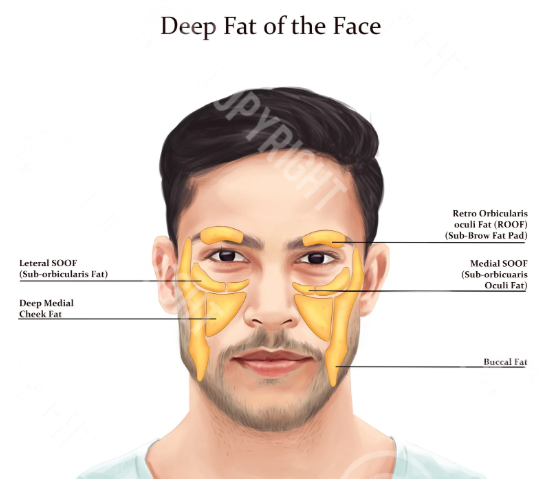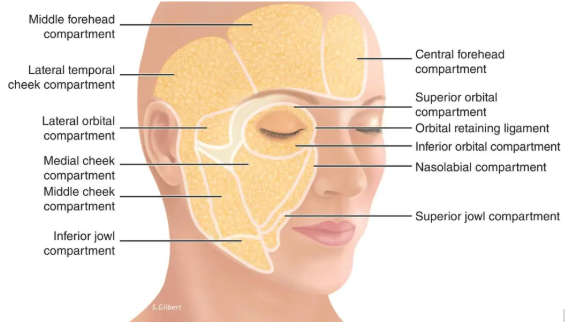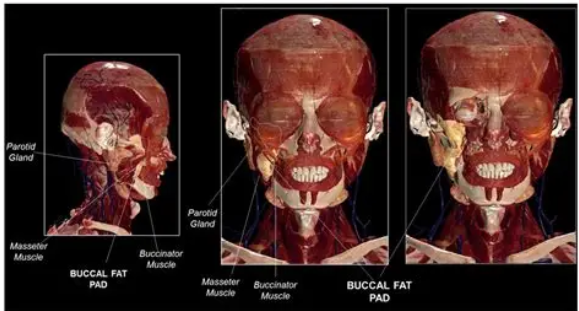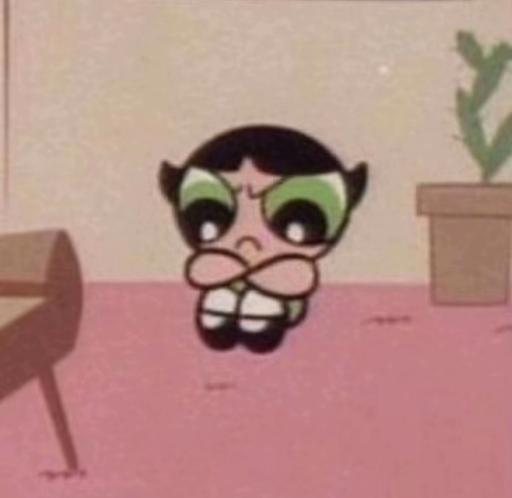Hunter
There’s levels to this shit.
- Joined
- Aug 24, 2025
- Posts
- 2,670
- Reputation
- 6,622
Table of Contents will include:
Why youth bodyfat determines your face long-term
So to start off, for facial fat pads there are both superficial and deep fat compartments in the face, not just one blob of fat. https://pubmed.ncbi.nlm.nih.gov/17519724/
Superficial pads are just under the skin, above the SMAS (a key soft-tissue layer).
https://entokey.com/2-aesthetic-anatomy-of-the-upper-face/?
Deep pads lie beneath that, closer to the bone, which also provides structural support.
https://pubmed.ncbi.nlm.nih.gov/30698919/
Most guys think face shape is just “muh bone structure”, but your soft-tissue “architecture” holds/determines pretty much what you’ll look like during childhood, teen years and adolescence as well. The fat pads in your face don’t stay the same size your whole life. They grow, shrink, stretch, and adapt depending on the long term load placed on them (aka bf% mainly).
This is obviously long term over the span of years.
Holding more body fat when you’re young doesn’t just give a “chubby face.” It actually influences the actual volume/capacity of your facial fat pads especially the ones in the midface which then affects how your adult face looks even when you cut later on.

How Facial Fat Pads Develop during Youth
Your face has a bunch of separate pockets, each with its own blood supply and boundaries. During youth, these compartments are more plastic, meaning they adapt more to upward or downward pressure.
If you stay lean your whole youth, you never “challenge” those compartments.
If you stay at a higher BF%, you give them more long-term volume and they’ll expand their holding capacity.
This is why some guys who were chubby as kids end up having that naturally round, full midface even when they later get lean. The compartments formed around more volume.

Why Higher BF% in Childhood/Teen Years Makes the Midface Look Rounder
The malar and medial cheek pads respond the most when retaining fat in your face. When they stay filled for years, the actual envelope that holds them becomes more spacious. Not like a balloon stretching once more like a soft material adapting to whatever sits inside it long-term.
So when you cut later, instead of deflating into a hollow, old ish midface, you get rounder, more youthful
Examples are: some dudes stay lean year-round and end up looking older or gaunt at 19, while others were bulkier as kids and have that “baby faced” fullness forever.

How Retaining Ligaments Respond to Long-Term Volume
Retaining ligaments anchor your soft tissue to the bone. They don’t just “hold fat pads in place.” They actually respond to the weight/volume sitting on them over years.
Examples of more volume:
• more downward tension
• more ligament stretch
• slightly looser boundaries
This is why someone who stayed very high BF% their whole youth might end up with:

Midface, Eye Area, Buccal Fat, bigonial/bizygos, What Actually Changes?
Midface (Infraorbital and Malar Area)
This is where most of the long-term changes happen. Youth volume gives you permanent “support” under the eye.
Buccal Fat
Buccal fat is different because it has a main body and branches and it’s more resistant to shrinking. People who were fatter young keep a bit more buccal fullness for life.
Parotid + Jowl Fat Pads
These pads don’t “grow” the same way, but long-term youth fullness prevents the skin from becoming paper-thin early.
Under-Eye Tear Trough
Youth fat keeps the ligament tight and the pad supported. Lean kids lose fat here permanently, leading to sunken eyes.
Bigonial/Bizygos
This is where people get confused. Fat doesn’t change bone, but it changes how strong your cheekbones read visually.
This is literally why former chubby kids sometimes look like they have ” high bone mass” the moment they lean down.

What’s the “Best” BF% for Your Face During Youth?
TlDR Based on anatomy patterns

Why Cutting Too Lean Too Young Can be retarded
Your face isn’t done developing (fat pads etc.) until your early 20’s,
Yeah so stay lean at 13,14, 15,16 with low nutrition and low BF%, and you basically fuck yourself and the compartments during the period when they were supposed to form.
Conclusion/TLDR
End your life if you can’t put yourself to spend 5 minutes reading.
Also don’t bother commenting.
@idkmanimao Helped make the thread.

- Introduction: Why youth bodyfat determines your face long-termHow
- Facial Fat Pads Develop during Youth
- Why Higher BF% in Childhood/Teen Years Makes the Midface Look Rounder
- How Retaining Ligaments Respond to Long-Term Volume
- Midface, Eye Area, Buccal Fat, bigonial/bizygos, What Actually Changes?
- What’s the “Best” BF% for Your Face During Youth?
- Why Cutting or staying too Lean Too Young Can Backfire
- Conclusion
Why youth bodyfat determines your face long-term
So to start off, for facial fat pads there are both superficial and deep fat compartments in the face, not just one blob of fat. https://pubmed.ncbi.nlm.nih.gov/17519724/
Superficial pads are just under the skin, above the SMAS (a key soft-tissue layer).
https://entokey.com/2-aesthetic-anatomy-of-the-upper-face/?
Deep pads lie beneath that, closer to the bone, which also provides structural support.
https://pubmed.ncbi.nlm.nih.gov/30698919/
Most guys think face shape is just “muh bone structure”, but your soft-tissue “architecture” holds/determines pretty much what you’ll look like during childhood, teen years and adolescence as well. The fat pads in your face don’t stay the same size your whole life. They grow, shrink, stretch, and adapt depending on the long term load placed on them (aka bf% mainly).
This is obviously long term over the span of years.
Holding more body fat when you’re young doesn’t just give a “chubby face.” It actually influences the actual volume/capacity of your facial fat pads especially the ones in the midface which then affects how your adult face looks even when you cut later on.

How Facial Fat Pads Develop during Youth
Your face has a bunch of separate pockets, each with its own blood supply and boundaries. During youth, these compartments are more plastic, meaning they adapt more to upward or downward pressure.
If you stay lean your whole youth, you never “challenge” those compartments.
If you stay at a higher BF%, you give them more long-term volume and they’ll expand their holding capacity.
This is why some guys who were chubby as kids end up having that naturally round, full midface even when they later get lean. The compartments formed around more volume.

Why Higher BF% in Childhood/Teen Years Makes the Midface Look Rounder
The malar and medial cheek pads respond the most when retaining fat in your face. When they stay filled for years, the actual envelope that holds them becomes more spacious. Not like a balloon stretching once more like a soft material adapting to whatever sits inside it long-term.
So when you cut later, instead of deflating into a hollow, old ish midface, you get rounder, more youthful
Examples are: some dudes stay lean year-round and end up looking older or gaunt at 19, while others were bulkier as kids and have that “baby faced” fullness forever.

How Retaining Ligaments Respond to Long-Term Volume
Retaining ligaments anchor your soft tissue to the bone. They don’t just “hold fat pads in place.” They actually respond to the weight/volume sitting on them over years.
Examples of more volume:
• more downward tension
• more ligament stretch
• slightly looser boundaries
This is why someone who stayed very high BF% their whole youth might end up with:
- looser midface tissue
- earlier sagging
- deeper nasolabial lines later in life

Midface, Eye Area, Buccal Fat, bigonial/bizygos, What Actually Changes?
Midface (Infraorbital and Malar Area)
This is where most of the long-term changes happen. Youth volume gives you permanent “support” under the eye.
Buccal Fat
Buccal fat is different because it has a main body and branches and it’s more resistant to shrinking. People who were fatter young keep a bit more buccal fullness for life.
Parotid + Jowl Fat Pads
These pads don’t “grow” the same way, but long-term youth fullness prevents the skin from becoming paper-thin early.
Under-Eye Tear Trough
Youth fat keeps the ligament tight and the pad supported. Lean kids lose fat here permanently, leading to sunken eyes.
Bigonial/Bizygos
This is where people get confused. Fat doesn’t change bone, but it changes how strong your cheekbones read visually.
- If you were too lean growing up, the cheeks never develop that “upper volume,” so when you cut later, you look narrow, basically like your zygos don’t project.
- If you grew up with a bit more fullness, the malar fat pads, the cheekbones. So when you finally go lean at 18–22, the zygos will be viewed as enlarged, because they’re sitting above a softly filled midface instead of collapsing.
This is literally why former chubby kids sometimes look like they have ” high bone mass” the moment they lean down.

What’s the “Best” BF% for Your Face During Youth?
TlDR Based on anatomy patterns
- Too lean (sub-10% at like age 12–17)
You’re basically preventing fat pad growth lol, this should be pretty water. These guys grow up with hollow midfaces and look like shit.. - Moderate (15–20%)
Ideal. Keeps the face youthful but doesn’t overstretch ligaments. - Fat nigger (25%+) You’ll gain more fat pad volume, but you risk ligament stretching and sagging later on (aka looking like some deformed fag).

Why Cutting Too Lean Too Young Can be retarded
Your face isn’t done developing (fat pads etc.) until your early 20’s,
Yeah so stay lean at 13,14, 15,16 with low nutrition and low BF%, and you basically fuck yourself and the compartments during the period when they were supposed to form.
Conclusion/TLDR
End your life if you can’t put yourself to spend 5 minutes reading.
Also don’t bother commenting.
@unon @BigBallsLarry @Orka @chadisbeingmade @SlayerJonas
@Aryan Incel @Volksstaffel @aids @Org3cel @Blackpillirony

Last edited:







